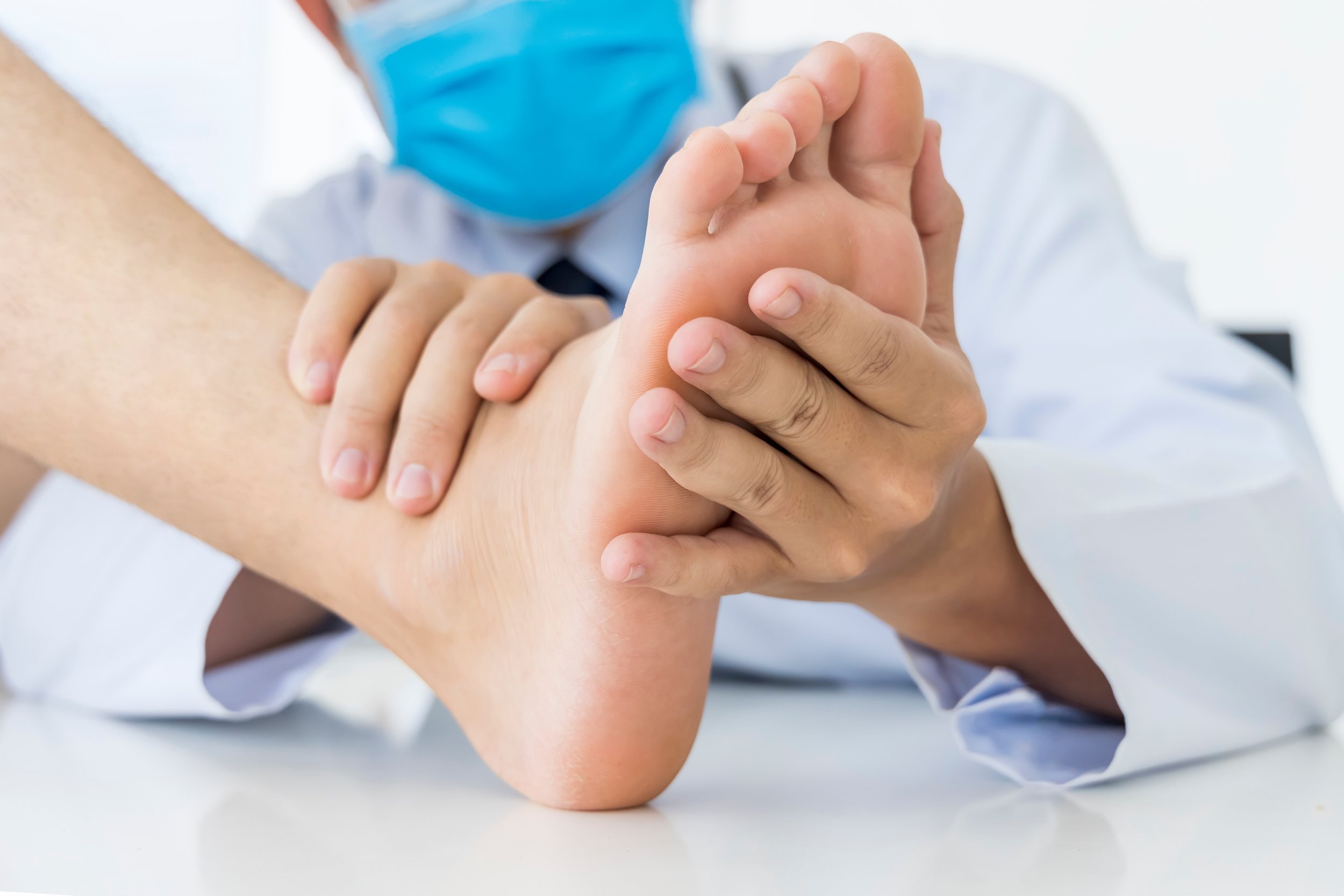An Innovative Orthotic Product for the Prevention and Treatment of Equinus Contracture
Understanding the condition
Introduction to our blog article on managing equinus contractures with the 654SKG (Dynamic Dorsi Assist) orthosis.
A so-called, equinus contracture is a common but challenging condition for the clinician (and patient) to deal with. In our work with people who have a physical disability, it is a complication we see following a stroke or other neurological conditions such as cerebral palsy which present with altered muscle tone. This has consequences for mobility and therefore has a significant impact on the quality of life of affected individuals.
An equinus foot position is shown on the right
The movement of the foot that occurs could potentially be described as equinovalgus or equinovarus depending on whether the foot is seen to be positioned in a particular way. Most commonly this will be equinovarus.
The term "equinovarus," like a lot of medical terminology, has its roots in Latin. It's derived from two separate terms: "equinus" and "varus."
"Equinus" comes from the Latin word for "horse." In a medical context, it refers to a condition where the foot and ankle are in plantar flexion, similar to the foot position of a horse.
"Varus" is a Latin term that means "inverted and adducted." In medical terminology, it's used to describe a condition where a part or joint of the body is deviated medially, i.e., towards the body's midline.
So, "equinovarus" essentially describes a condition where the foot is positioned downwards and then rotated inwards, mimicking the stance of a horse and exhibiting medial deviation.
The images show separately what is meant by equinus, valgus and varus.
The problem with equinus contractures
Equinus contracture is often due to an acquired muscle imbalance across the ankle joint. By this, I mean perhaps one muscle group is weak and another relatively strong. This might not be within our conscious control - some conditions affect the tone of muscles even when we are at rest, resulting in this muscle "imbalance" across the joint.
A clinician will assess the movement and relative strength of the muscles
This imbalance will over time result in this type of contracture. A clinician will typically look to assess the relative strength of the muscles surrounding the joint and this will often change over time as the body adapts to the situation. We might see a relative tightness in the muscles or tendon structures of the calf that then restrict the range of motion at the joints. Equinus contracture can affect one or both feet.
When we lose the natural ability to move our foot and ankle through a normal range of motion, it clearly will affect our ability to walk and balance. If we use a person recovering from a stroke as an example, the development of such a contracture will mean that their mobilisation can be delayed.
Treatment for equinus contractures
Treatment for equinus contracture varies based on the cause and severity of the condition. Options range from minor adjustments in footwear; including arch support, heel lifts, and custom orthotics. In some cases, doctors may recommend "night splints" to maintain the leg in a position that improves flexibility. We will come back to discuss this option shortly.
For severe cases of equinus deformity, surgical intervention may be offered. Techniques such as midfoot osteotomies and gradual correction using an external fixator may be employed. In instances where the patient cannot comply with the gradual correction technique, the deformity can be corrected by talectomy and tibiocalcaneal fusion.
Understanding equinus contracture and its treatment options is crucial for anyone dealing with this condition.
Prevention of equinus contracture
The primary goal should always be to prevent the development of these contractures if possible, as they can significantly hinder future mobility. For instance, a stroke patient with an acquired equinovarus foot can face substantial challenges in moving around, which may be crucial for maintaining their continuity of care. Once the deformity becomes established, the patient must adapt their gait by adjusting their foot, knee, and hip positioning. This can lead to further complications such as knee hyperextension and hip adduction, exacerbating the individual's disability.
Patients who have had a stroke may tend to develop an equinus contracture due to how muscle tone has changed during the recovery process. This contracture may be readily correctable in the early stages of recovery but if allowed to persist, will become very difficult to reverse.
A so-called "night splint" might be offered as an orthotic product that can prevent the development of a contracture. This, at it's simplest, is a plastic splint that fits over the foot and lower leg. It may allow the angle between the foot and ankle to be adjusted or it may be jointless.
Two problems arise with this type of product. If the orthosis is too flexible, it will not resist the forces that are generated and will not prevent the contracture from developing. Alternatively, if the orthosis is stiff enough to resist the forces generated by the muscles, the patient can be at risk of elevated pressure on the metatarsal heads and pressure sores. The orthosis used for this type of application should dynamically manage the forces generated by the muscles but also protect the tissues from pressure ulcers.
What is the DDA orthosis?
The 654SKG Dynamic Dual Action Orthosis, also known as DDA Orthosis, is gaining recognition for its ability to prevent and even reverse heel contractures.
This orthotic device addresses critical concerns related to tissue health and corrective biomechanics, making it a valuable tool in various crucial clinical settings including acute stroke units, critical care, spinal cord injury, cerebral palsy and vascular wards.
The 654SKG DDA comes standard with a Kodel liner that can be cleaned and replaced as needed. This feature supports tissue health and allows the device to be used across a wide array of clinical conditions. If the foot has wound dressings that make the use of Kodel challenging, a "Pad and Strap" kit is available to accommodate any dressings.
The dynamic stretch, also known as dorsiflexion assist, is facilitated by two elastic straps located on the medial and lateral sides. These straps can be individually adjusted to counteract any common tendencies towards equinovarus or valgus deformities. A brief video demonstrates the fundamental movements of the product.
Guidelines for proper utilisation of the DDA orthosis
The medial and lateral elastic straps of the DDA Orthosis function effectively due to the hinged heel section, which allows the foot section to move and maintain close contact with the foot's sole. This is crucial as it prevents pressure from increasing on the metatarsal heads while ensuring no pressure is exerted on the sensitive heel area.
Like all items in the PRAFO range, the design offers effective heel protection by eliminating pressure on the heel area. To use the product, open the liner, position the orthosis to place the heel at the back of the device, secure and adjust the forefoot velcro straps, followed by the tibial pad and strap. You can then set the tension of the elastic straps.
The elastic straps play a pivotal role in dynamic management. In cases where the patient experiences clonus, causing repeated high pressures between the foot and the device, the elastic straps of the DDA can accommodate these pressures without jeopardising overall tissue health. The DDA can safely respond to this situation while maintaining the potential for corrective force.
As mentioned above, common issue with other heel protection products is their tendency to deform into a plantarflexed position without maintaining adequate contact with the entire foot, putting the metatarsals at risk of ulceration.
For patients who can mobilise, the DDA comes with an inherent walking base that facilitates safe mobility.
Conclusion
In conclusion, equinus contracture is a medical condition that can cause considerable impairment in patients with a variety of clinical conditions. Timely attention to both tissue health and the biomechanics of the foot and ankle is crucial for prevention and necessary for effective treatment.
The 654 DDA Orthosis is an easy-to-use dynamic orthotic device that has demonstrated its effectiveness in not just halting, but also reversing this condition. It provides necessary heel protection and support, promoting a healthier and more comfortable solution for patients.
It's worth noting that the 554SKG model is available for pediatric use.
For those suffering from heel contracture, considering the 654SKG DDA Orthosis could be beneficial. However, it's important to consult with an orthotist, physiotherapist, or other healthcare professional before starting to use any device for the prevention or treatment of this condition.






